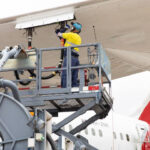In its economic outlook for the coming year, IATA expects the aviation industry to increase the use of sustainable aviation fuels and carbon credits to reduce its carbon footprint. Estimates have put the share of SAF in the global jet fuel mix at around 0.1% but the airline body is estimating production could rise to 0.53% of total fuel consumption in 2024, adding $2.4 billion to the sector’s fuel bill. Airlines spent around $190 billion on fuel in pre-pandemic 2019, representing 24% of total operating expenses, and is estimated to rise to $271 billion in 2023, a 32% share of operating expenses, on the back of the increase in the price of jet kerosene since the end of the pandemic. Fuel consumption in 2019 totalled 96 billion gallons and with the continued recovery of the industry since the end of Covid, consumption is expected to reach 94 billion gallons in 2023 and rise to 99 billion gallons next year, resulting in industry CO2 emissions of 939 million tonnes, surpassing those of 2019. IATA estimates that airline costs related to complying with ICAO’s CORSIA carbon offsetting scheme will be in the region of $1 billion in 2024.
IATA expects 4.7 billion people to travel in 2024, an historic high that exceeds the pre-pandemic level of 4.5 billion recorded in 2019. “People love to travel and that has helped airlines to come roaring back to pre-pandemic levels of connectivity,” commented IATA Director General Willie Walsh on the publication of IATA’s latest economic outlook. “The speed of the recovery has been extraordinary, yet it also appears that the pandemic has cost the industry about four years of growth. From 2024 the outlook indicates that we can expect more normal growth patterns for both passenger and cargo.”
Total airline revenues in 2024 are expected to grow 7.6% year on year to a record $964 billion, with operating profits reaching $49.3 billion in 2024, up from $40.7 billion in 2023. Expense growth is expected to be slightly lower at 6.9% for a total of $914 billion.
However, pointed out Walsh, industry profits had to be put into perspective. “While the recovery is impressive, a net profit margin of 2.7% is far below what investors in almost any other industry would accept,” he said. “Of course, many airlines are doing better than that average, and many are struggling. But there is something to be learned from the fact that, on average, airlines will retain just $5.45 for every passenger carried.”
The additional SAF and CORSIA costs in 2024 “will add more pressure to the already fragile profitability of the industry,” warns IATA in its Global Outlook for Air Transport.
Passenger load factors are now nearly back to the pre-pandemic 2019 level of 82.6%, with 82.0% expected in 2023 and 82.6% forecast for 2024. Overall industry fuel efficiency (measured in litres of fuel per 100 ATKs) has remained static since 2019 and expected to marginally improve in 2024. Aircraft deliveries will increase in 2023 compared to 2022 but remain below 2019 levels as a result of ongoing supply chain issues creating production delays. However, said IATA, airlines globally are seeking to acquire more fuel-efficient and quieter aircraft with large orders continuing to be placed, with a trend towards narrowbody aircraft and the number of orders for regional aircraft and widebody aircraft stagnating. According to current schedules, the number of new aircraft deliveries will reach 1,777 in 2024 and 2,075 in 2025, a record in the history of commercial aviation.
IATA estimates the industry will consume between 450,000 and 500,000 tonnes (around 600 million litres) of SAF in 2023, double that of 2022, at a price of $2,500 per tonne – or 2.8 times that of jet kerosene – and add $756 million to the industry fuel bill this year. SAF accounted for 3% of all renewable fuels produced, with the remainder going to other sectors. In 2024, SAF production is expected to triple to 1.5 million tonnes (1.875 billion litres), accounting for 0.53% of aviation’s fuel need.
“The doubling of SAF production in 2023 was encouraging, as is the expected tripling of production expected in 2024. But even with that impressive growth, SAF as a portion of all renewable fuel production will only grow from 3% this year to 6% in 2024,” said Walsh. “This allocation limits SAF supply and keeps prices high. Aviation needs between 25% and 30% of renewable fuel production capacity for SAF. At those levels, aviation will be on the trajectory needed to reach net zero carbon emissions by 2050. Until such levels are reached, we will continue missing huge opportunities to advance aviation’s decarbonisation.
“It is government policy that will make the difference. Governments must prioritise policies to incentivise the scaling up of SAF production and to diversify feedstocks with those available locally.”
The recent global framework agreement by governments at the Third Conference on Aviation Alternative Fuels (CAAF/3) in Dubai (see article) set a target of fuels used in international aviation be 5% less carbon intensive by 2030. IATA estimates that to reach this level, about 17.5 billion litres (14 million tonnes) of SAF needs to be produced. At least 43 airlines have already committed to using 16.25 billion litres (13 Mt) of SAF in 2030, with more agreements being announced regularly, it said.
Projections are for over 78 billion litres (63 Mt) of renewable fuels to be produced in 2029. “Governments must set a policy framework that incentivises renewable fuel producers to allocate 25-30% of their output to SAF to meet the CAAF/3 ambition,” said IATA. Such incentives should:
- Accelerate investments in SAF by traditional oil companies;
- Ensure renewable fuel production incentives encourage sufficient SAF quantities ;
- Focus stakeholders on regional diversification of feedstock and SAF production;
- Identify and prioritise high potential projects for investment support; and
- Deliver a global SAF Accounting Framework.
With around 85% of SAF facilities coming on line in the next five years using HEFA production technology that will rely on increasingly limited quantities of feedstocks, such as used cooking oil, tallow and industrial greases, IATA says policies are needed to:
- Diversify SAF production by increasing production through pathways already certified, in particular alcohol-to-jet and Fischer-Tropsch, which use bio/agricultural wastes and residues;
- Promote investments in, and the fast-tracking of certification for, new SAF production pathways currently in the development phase; and
- Identify more potential feedstocks to leverage all SAF technologies to provide diversification and regional options, including those with side benefits such as environmental restoration.
IATA said a recent survey it carried out revealed significant public support for SAF, with 86% of travellers agreeing that governments should provide production incentives for airlines to be able to access SAF, and the same proportion agreeing it should be a priority for oil companies to supply SAF to airlines.
Meanwhile, IATA has announced expanded capabilities to its Global Aviation Data Management (GADM) programme. GADM’s data comes from several sources, including the Incident Data Exchange (IDX) and the Flight Data eXchange (FDX), the latter now comprising data from 15 million flights performed by 7,500 aircraft and contributed by 198 airlines. IATA will use GADM operational data to enhance the analysis done by its fuel experts and provide industry benchmarks related to fuel efficiency.
The data will also lead to more granular measurement of aircraft fuel burn and tracking of CO2 emissions. With analysis of hundreds of data parameters at every second of flight, IATA says it is also possible to identify the precise impact of fuel saving operational measures.
To support the increased focus on data, IATA is establishing a new division responsible for data management, strengthening the GADM team and expanding its team of data scientists.
Photo: Airbus















More News & Features
Catagen launches SAF production company and signs offtakes with Ryanair and Shell
Australia announces A$1.1bn incentive scheme to drive local production of low carbon fuels including SAF
Oneworld airline partners join with Breakthrough Energy Ventures to invest in new SAF technologies
New Danish measures emerge to reduce aviation’s air and ground emissions
More targeted and faster measures needed to overcome barriers and unlock SAF’s full potential, finds PA study
SAF production and procurement deals inked in China and other Asia regions